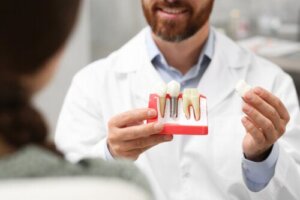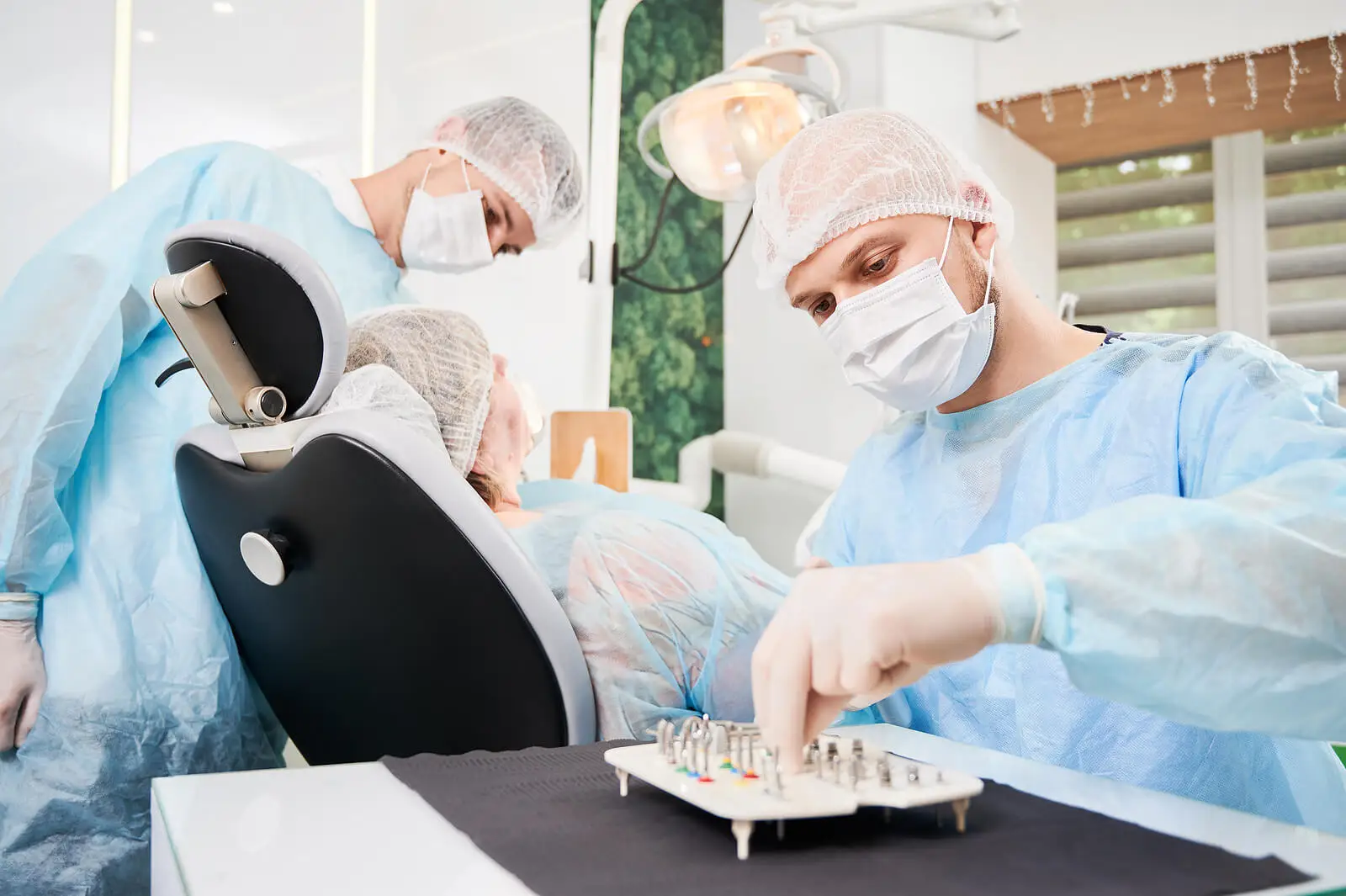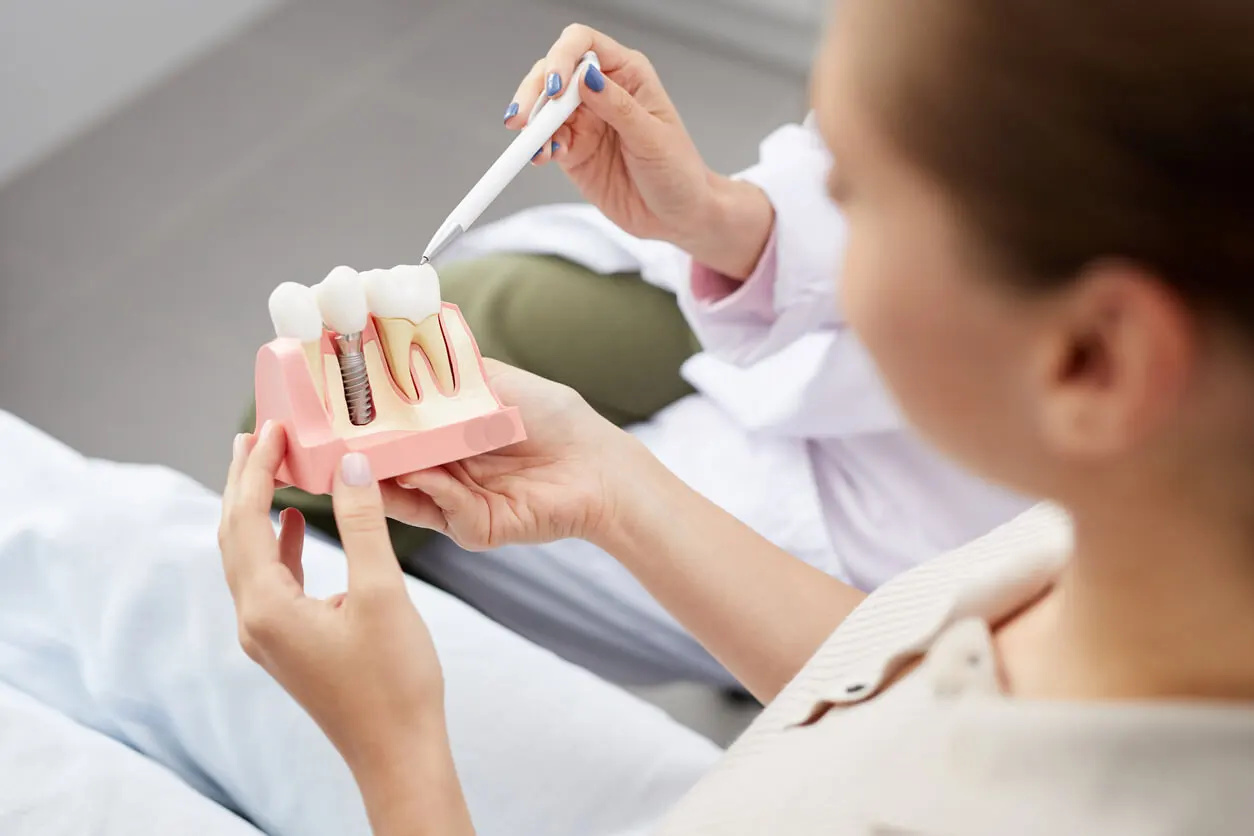Oral Rehabilitation on Implants: What Does This Treatment Consist Of?


Written and verified by the dentist Vanesa Evangelina Buffa
Oral rehabilitation on implants is currently the most commonly used treatment to replace missing teeth. It allows for the recovery of the functions and esthetics of the smile in a stable way.
In particular, two fundamental steps are necessary. First, the implants are placed inside the bone and their healing is awaited. Then, once they’re fixed to the bone tissue, the prostheses are placed over them.
Of course, there are several denture alternatives that are attached to the implants to complete the rehabilitation. In this article, we’ll tell you more about this intervention and all its implications. Read on to learn more!
What is oral rehabilitation on implants?
Oral rehabilitation on implants is a dental treatment used to replace missing teeth. It’s based on placing metal attachments in the thickness of the jaws so that prostheses containing artificial teeth can be placed on them to replace the missing teeth.
During surgery, the implant is placed inside the bone tissue of the jaws. These attachments are made of titanium, a biocompatible material that allows the metal to bond with the bone.
This process of combination between titanium and bone tissue is known as “osseointegration.” It’s this special healing that is responsible for the stability and durability of this treatment since the screws remain fixed to the bone and can hold the prosthesis without coming out or moving.
Once the osseointegration process is completed – between 3 and 6 months – the dentist can place the prosthesis on the screw. Depending on the number of missing teeth and the particular needs of the case, he/she may opt for different alternatives, as you will see below.
Prostheses on implants give the person back the ability to bite, speak, and smile as before. For this reason, they’re one of the most chosen oral rehabilitation options today.
They have the particular feature of achieving excellent esthetics and giving the smile a natural appearance that’s similar to the original dentition itself. In addition, this is a stable and long-lasting option.

We think you may be interested in reading this, too: 9 Natural and Effective Tips for Taking Care of Your Teeth
The advantages of oral rehabilitation on dental implants
We’ve already mentioned several of the benefits of oral rehabilitation on implants. Below, we’ll take a closer look at its main advantages:
- Stability: Dentures on implants usually have no or low mobility. The person can eat and speak without the prosthesis loosening, moving, or coming out.
- Naturalness: This is the rehabilitation method that achieves greater similarity with the natural tooth structure. It not only restores the crown portion of the teeth, but also has a root sector as it has a component inside the bone.
- Recovery of functions: The patient recovers the ability to chew, speak, eat and smile normally.
- Comfort: The good fit and the reduced friction of the prosthesis with the mucous membranes generate a better experience for the patient who gets used to the presence of the denture and exercises oral functions naturally.
- Bone preservation: The presence of the implants inside the bone tissue and the reception of the stimuli generated by the prosthesis help to maintain the thickness of the bone and prevent its resorption.
The importance of rehabilitating the dentition
When one or more teeth are lost, it’s not only the aesthetics of the smile that is altered. The functions of the mouth are also modified and damage is caused to the oral balance. Failure to find an alternative to rehabilitate the oral cavity and replace missing teeth leads to problems with speaking, chewing, and eating.
In addition, the lack of teeth causes overload and excessive wear of the elements that remain in the mouth. Among other things, this can lead to the mobility of the other dental elements that try to cover the space left by the missing piece.
Thus, the bite may become altered and occlusion problems can be generated. In turn, the absence of tooth roots inside the bone causes the loss of bone tissue. Since they don’t receive any stimulus or chewing forces, this area of the jaws is therefore resorbed.
Teeth support the soft structures of the mouth and face. Without the teeth, the lips and cheeks lose this support and tend to sag. The face thus takes on a wrinkled and aged appearance.
These problems can be avoided if an alternative is sought to replace the missing teeth. Oral rehabilitation on implants is the option that provides the greatest benefits when it comes to preventing the consequences of missing teeth.
Types of oral rehabilitation on implants
As we’ve already mentioned, when it comes to oral rehabilitation on dental implants there are several options for replacing missing teeth. Depending on the number of missing elements and the needs and interests of the patient, various types of prostheses can be used. Let’s take a look at them.
Single fixed rehabilitation on implants
This is used when only one tooth is missing. As the name indicates, the crown that replaces the dental element is permanently fixed to the implant – that is, the patient can’t remove it.
Partial or complete fixed rehabilitation on implants
This is a prosthesis that replaces all the pieces that are missing in the mouth. However, unlike the classic dentures, these are only composed of the dental part, without the pink part that emulates the gums.
It’s fixed to several implants – from 4 to 8 depending on the case – and strategically placed in different points of the jawbone.
Overdenture rehabilitation on implants
This consists of a solid structure -similar to conventional dentures- which is placed over the implants, but with the particularity that the patient can remove it to clean it. When it’s placed, it remains attached to the attachments without moving or coming off.
Hybrid rehabilitation on implants
This is a type of denture that’s composed of the denture portion and the pink gums. It uses as support for the anchorage provided by the implants and also the support on the gum mucosa.
It’s screwed to the implants and can only be removed by the dentist. It’s useful for patients with a lot of bone loss.

Like this article? You may also like to read: Seven Home Remedies for Removing Plaque From Your Teeth
Care and precautions to keep in mind
Oral rehabilitation on implants is one of the most stable and durable solutions to restore oral functions after tooth loss. Its implementation helps to return to chewing, eating, speaking, and smiling with security and confidence.
However, for the treatment to be successful, some maintenance and care are necessary. In this regard, good oral hygiene is of utmost importance. Therefore, the following should be applied:
- Brush your teeth, gums, and tongue regularly.
- Use dental floss.
- Use fluoride toothpaste.
- Complement your dental hygiene with the use of mouthwash.
All of the above prevents the accumulation of bacteria and debris and, incidentally, reduces the risk of complications. Even so, it’s advisable to visit your dentist periodically to check that everything is going well and to detect any possible condition in time.
With simple, daily care, oral rehabilitation on implants can last a lifetime. Laughing, eating, and speaking will no longer be a problem due to missing teeth.
All cited sources were thoroughly reviewed by our team to ensure their quality, reliability, currency, and validity. The bibliography of this article was considered reliable and of academic or scientific accuracy.
- Pacheco Merchán, G. A. (2019). Osteointegración.
- Díaz Reyes, K. Y. (2017). Prótesis híbridas sobre implantes dentales, indicaciones, protocolo de manejo clínico y laboratorio.
- Morgan, Y. G., Piñeiro, Y. F., & Reymon, A. E. C. (2022). Prótesis sobre implantes: la nueva sonrisa del adulto mayor. Medimay, 29(1), 104-118.
- Berro, M., Samprón, M. L., & Tomaghelli, E. R. (2020). Rehabilitación sobre implantes: Sobredentadura. In IV Jornadas de Actualización en Prácticas Odontológicas Integradas PPS-SEPOI (La Plata, 7 de julio de 2020).
- Fernández, C. A., Soria, G. A. L., & Villarb, F. A. (2020). Prótesis sobre implantes.¿ Atornillada o cementada?. Rev. Asoc. Odontol. Argent, 29-39.
- Infante Rodríguez, L. (2021). Diseño de sobredentaduras implanto-retenidas de maxilar superior. Repercusiones, ventajas e inconvenientes de la presencia o no de recubrimiento palatino. Revisión bibliográfica.
- Lemus Cruz, L. M., Justo Díaz, M., Almagro Urrutia, Z., Sáez Carriera, R., & Triana, K. (2009). Rehabilitación sobre implantes oseointegrados. Revista Cubana de Estomatología, 46(1), 0-0.
This text is provided for informational purposes only and does not replace consultation with a professional. If in doubt, consult your specialist.








